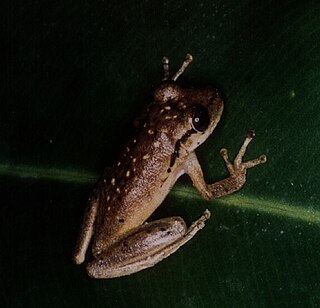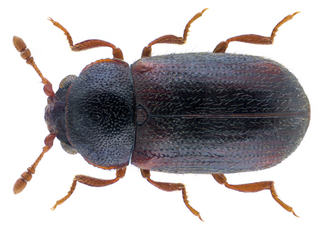
Marmots are large ground squirrels in the genus Marmota, with 15 species living in Asia, Europe, and North America. These herbivores are active during the summer, when they can often be found in groups, but are not seen during the winter, when they hibernate underground. They are the heaviest members of the squirrel family.

Cortinarius is a globally distributed genus of mushrooms in the family Cortinariaceae. It is suspected to be the largest genus of agarics, containing over 2,000 widespread species. A common feature among all species in the genus Cortinarius is that young specimens have a cortina (veil) between the cap and the stem, hence the name, meaning curtained. Most of the fibres of the cortina are ephemeral and will leave no trace once gone, except for limited remnants on the stem or cap edge in some species. All have a rusty brown spore print. The common names cortinar and webcap refer to members of the genus. Due to dangerous toxicity of several species and the fact that it is difficult to distinguish between various species of the genus, non-expert consumption of mushrooms from the genus is discouraged.

Scinax is a genus of frogs in the family Hylidae found in eastern and southern Mexico to Argentina and Uruguay, Trinidad and Tobago, and Saint Lucia. These are small to moderate-sized tree frogs, drably colored. Duellman and Wiens resurrected this genus in 1992. The name originates from the Greek word skinos, meaning quick or nimble.

Capitosaurus is an extinct genus of temnospondyl amphibians whose remains have been found in Spitsbergen and Germany. Its skull was 30 cm long, with a total length over 122 cm. Several species have been assigned to the genus over the years, but only C. polaris is still valid today.

Urocordylus is an extinct genus of nectridean lepospondyl. It is the type genus of the family Urocordylidae. Fossils have been found from Ireland that date back to the Westphalian stage of the late Carboniferous. This lepospondyl had total length of about 19.5 in (500 mm), but skull length was only about 1.3 in (33 mm).

Tselfatia is an extinct genus of Cretaceous bony fish. Originally described from Djebl Tselfat in Morocco, it has since been discovered at sites in several other countries. The type species, Tselfatia formosa, was named and described in 1944 by French paleontologist Camille Arambourg. A second species, T. dalmatica, was named in 1980 from the Dalmatian Coast of Yugoslavia.

Hydrochus is the only living genus of beetle in the family Hydrochidae, which belongs to the superfamily Hydrophiloidea. Hydrochus includes about 180 species, which are found worldwide. Hydrochus has also been used for a fly genus in the family Dolichopodidae. This junior homonym is a junior subjective synonym of the genus Rhaphium.
Curalium is a genus of true bug that is the sole member of the insect family Curaliidae. Curalium contains a single species, Curalium cronini.

Sphindidae is a family of beetles, in the suborder Polyphaga. They are also known as slime mold beetles due to their exclusive feeding on slime molds during adult and larval stages, other aspects of their life history are obscure. Palaeontological discoveries since 2015 have added to the geologic history of Sphindidae, including the discovery of Libanopsis, placed in the extinct subfamily Libanopsinae.
Dendrolaelaps is a genus of mites in the family Digamasellidae. There are more than 170 described species in Dendrolaelaps.

Equus conversidens, or the Mexican horse, is a dubious Pleistocene species of horse, now extinct, that inhabited North America.
Polycynodon is an extinct genus of therocephalians from the Late Permian of South Africa. It is known from the Cistecephalus Assemblage Zone. The type species was first described as Octocynodon elegans by South African paleontologist Robert Broom in 1940, but the name Octocynodon was preoccupied by a genus of labrid fish first described in 1904. Along with John T. Robinson, Broom instated Polycynodon as a replacement name for O. elegans in 1948. Polycynodon is classified in Baurioidea, although its relationship to other baurioid therocephalians is uncertain.
Palaeospinax is an extinct genus of shark which lived from the Early Triassic to the end of the Eocene epoch. Although several species have been described, the genus is considered nomen dubium because the type-specimen of the type species, Palaeospinax priscus, lacks appropriate diagnostic characters to define the genus.

The Interim Register of Marine and Nonmarine Genera (IRMNG) is a taxonomic database which attempts to cover published genus names for all domains of life from 1758 in zoology up to the present, arranged in a single, internally consistent taxonomic hierarchy, for the benefit of Biodiversity Informatics initiatives plus general users of biodiversity (taxonomic) information. In addition to containing over 490,000 published genus name instances as at March 2020, the database holds over 1.7 million species names, although this component of the data is not maintained in as current or complete state as the genus-level holdings. IRMNG can be queried online for access to the latest version of the dataset and is also made available as periodic snapshots or data dumps for import/upload into other systems as desired.

Myrabolia is the only genus in the beetle family Myraboliidae in the superfamily Cucujoidea. It has about 13 species, found in Australia. Adults and possibly larvae live under the bark of Eucalyptus trees.
Chiroderma vizottoi is a species of frugivorous bat found in the northeast of Brazil.
Compsosaurus is an extinct genus of phytosaur, a crocodile-like reptile that lived during the Triassic. Its fossils have been found in North Carolina. The type species, Compsosaurus priscus, was named by American paleontologist Joseph Leidy in 1856, although other sources say 1857. Compsosaurus may have been the same animal as the related Belodon.

Notopleura is a genus of flowering plants in the family Rubiaceae, native to Central America, the Caribbean, and northern South America. They tend to be subshrubs, herbs and epiphytes.
Xhosacetus is a genus of ziphiid cetaceans with a single species, Xhosacetus hendeysi. It was classified from fossils found off the coast of the Kerguelen islands in 1,145 meter deep water.












